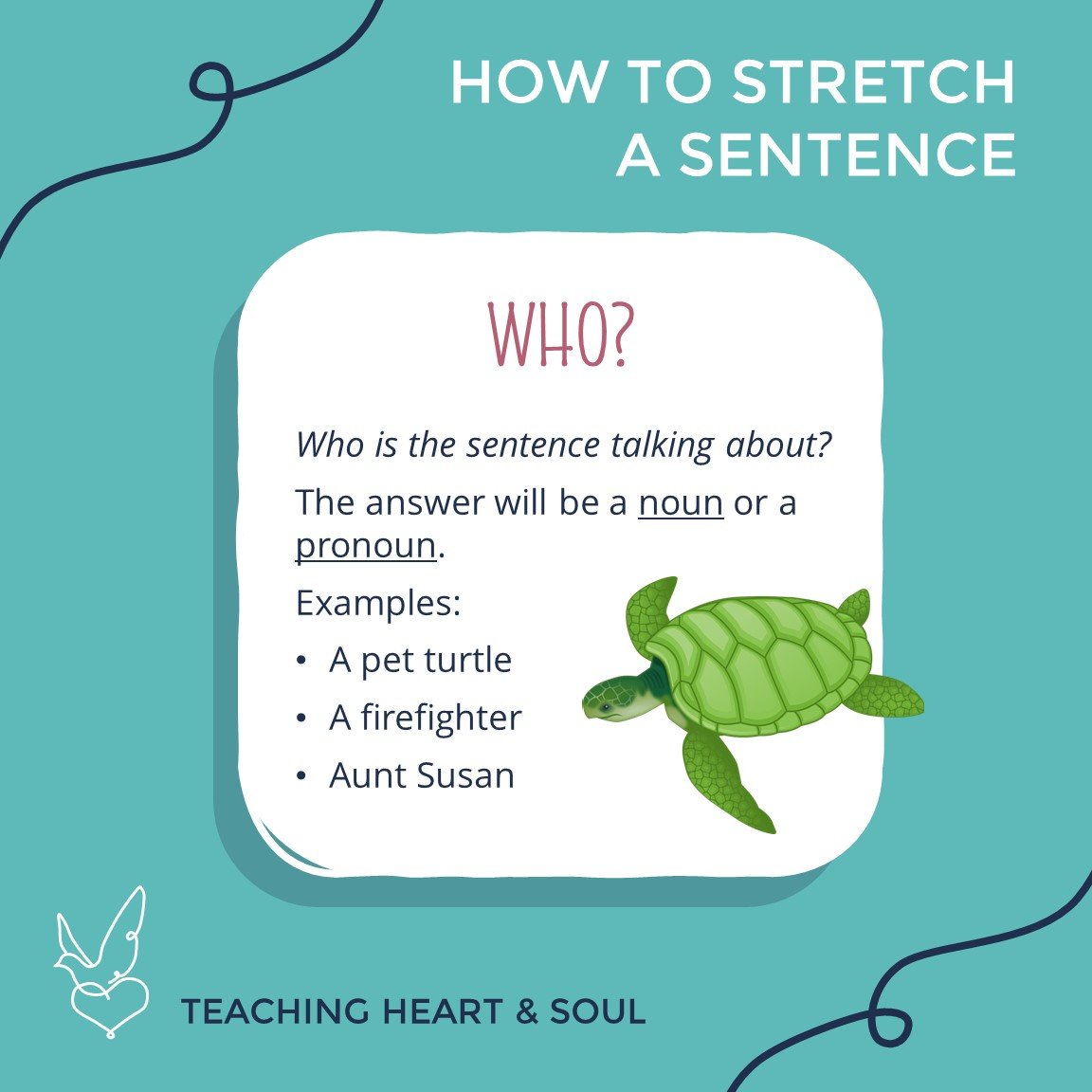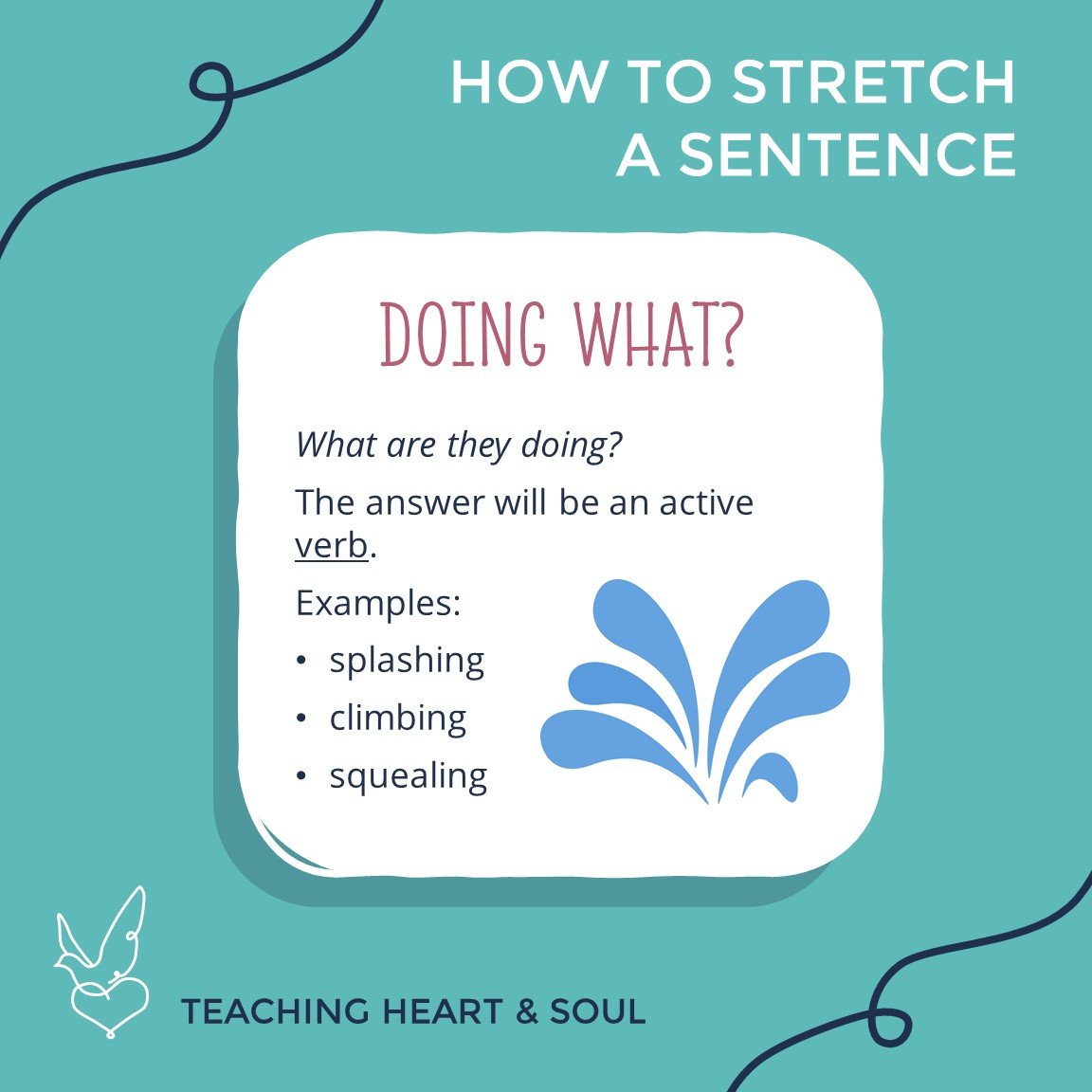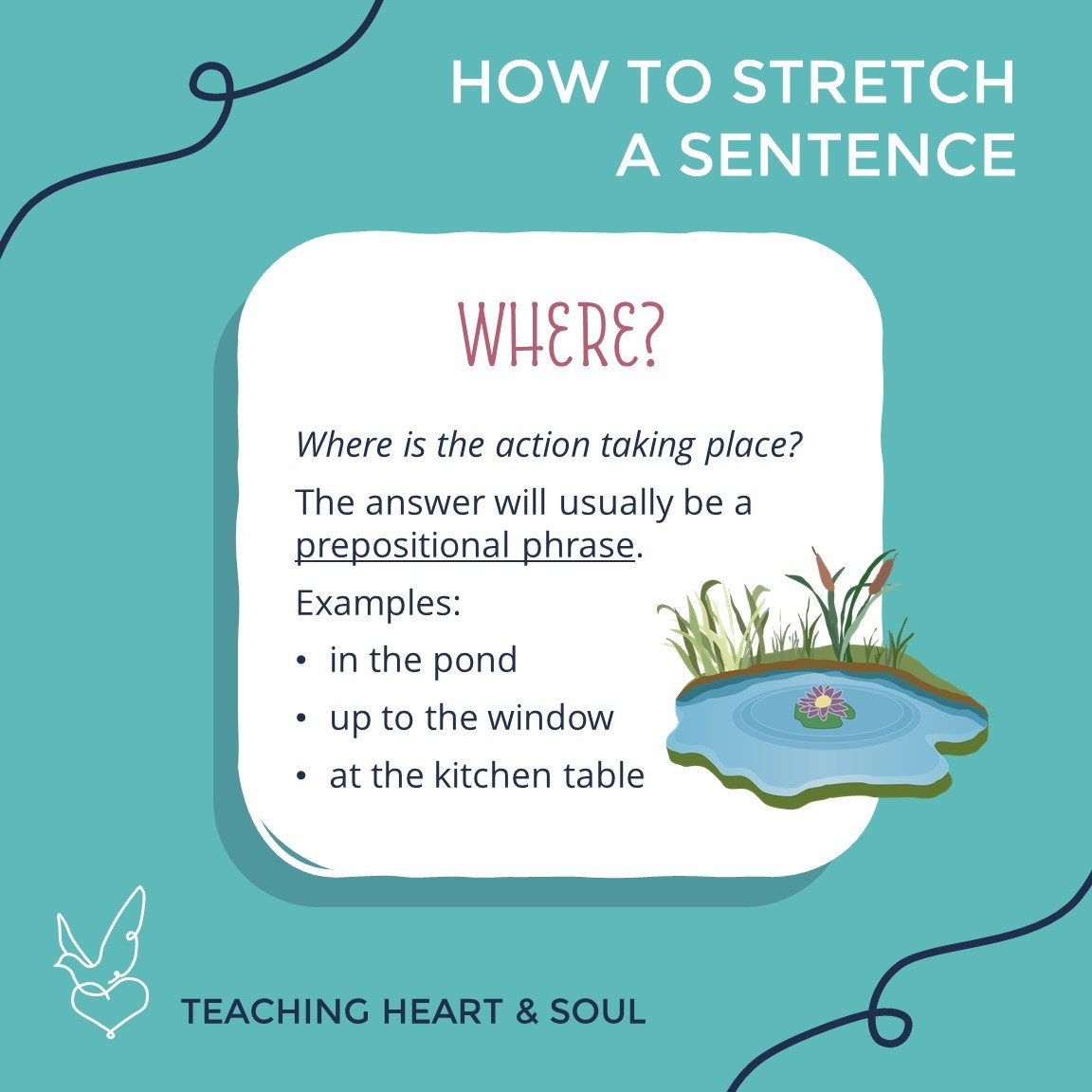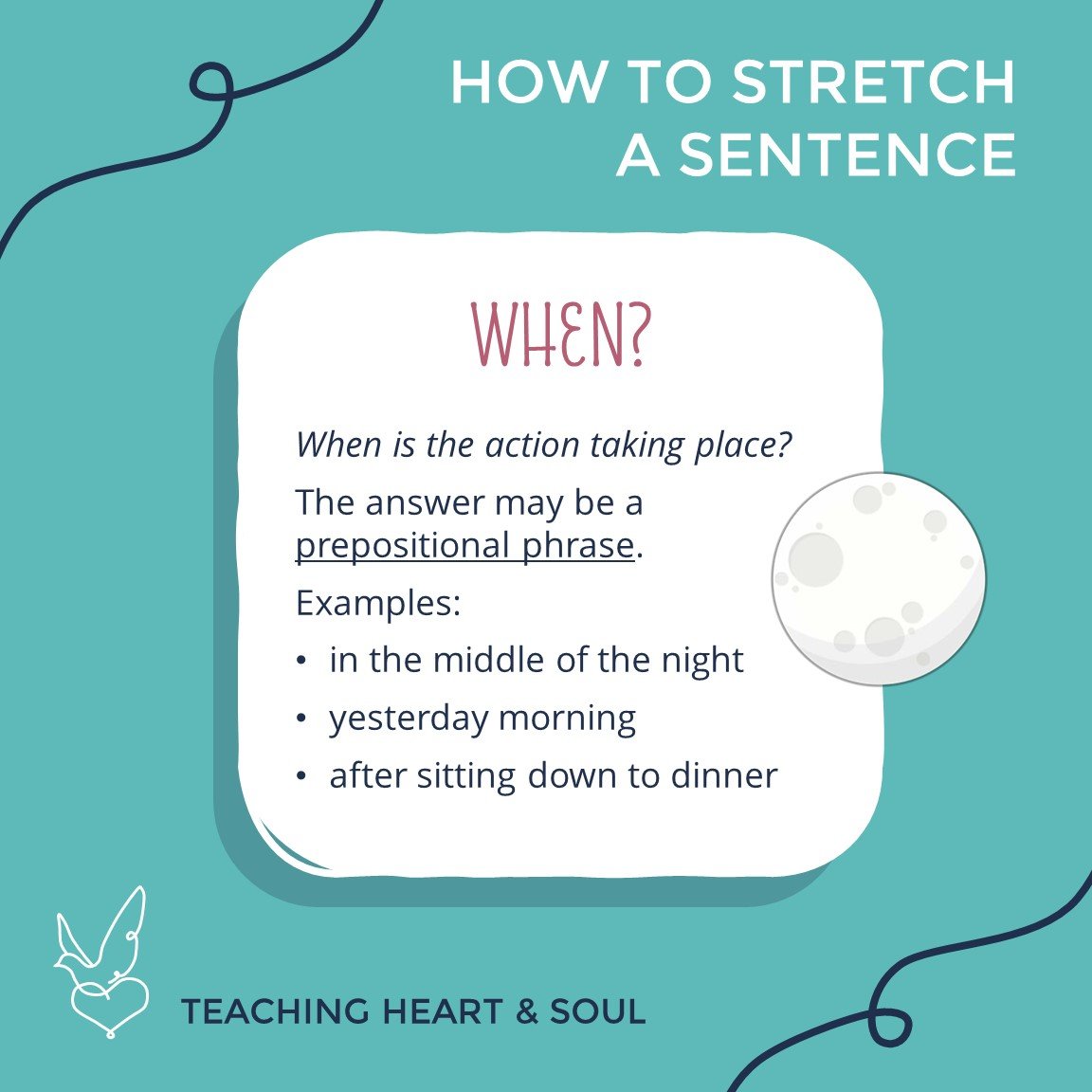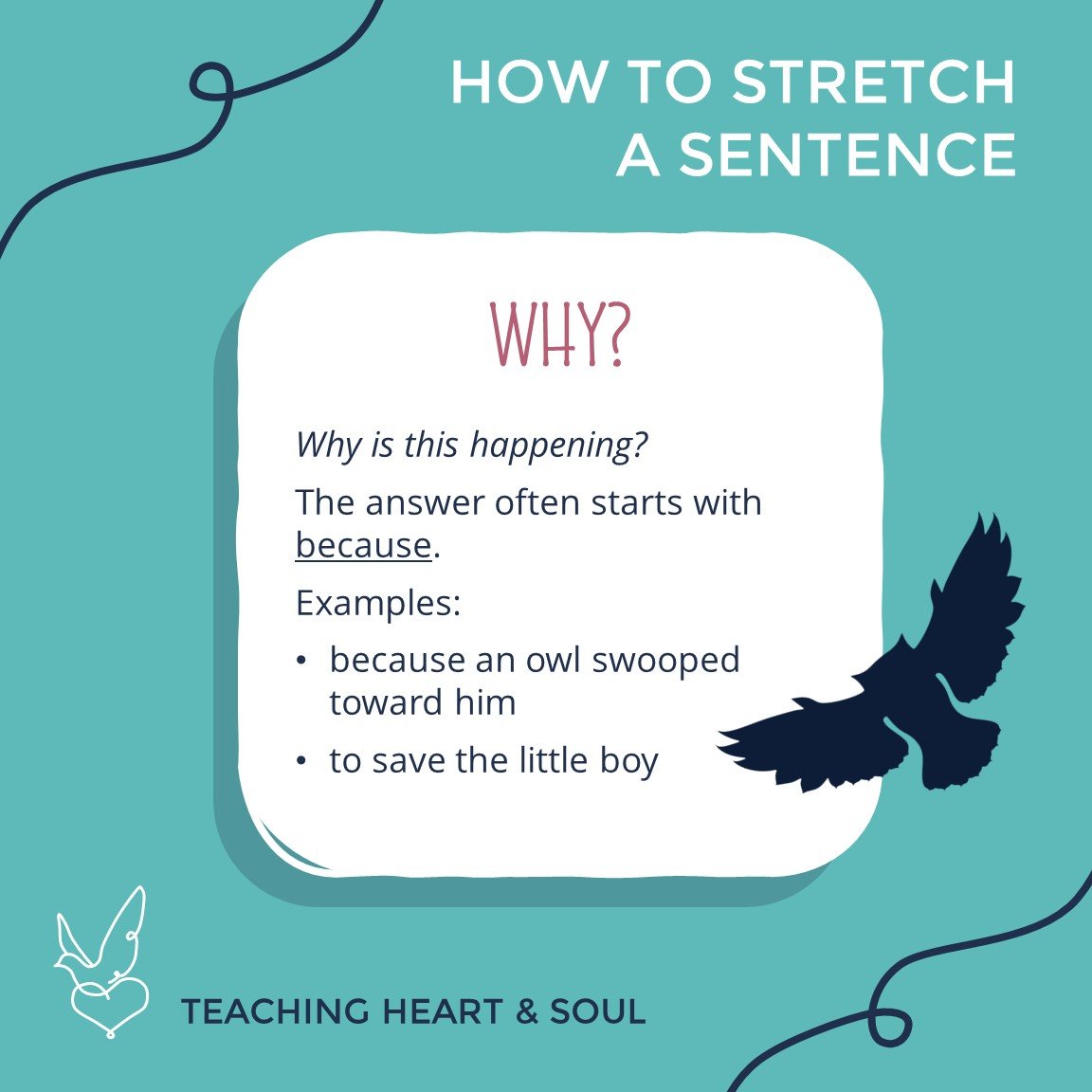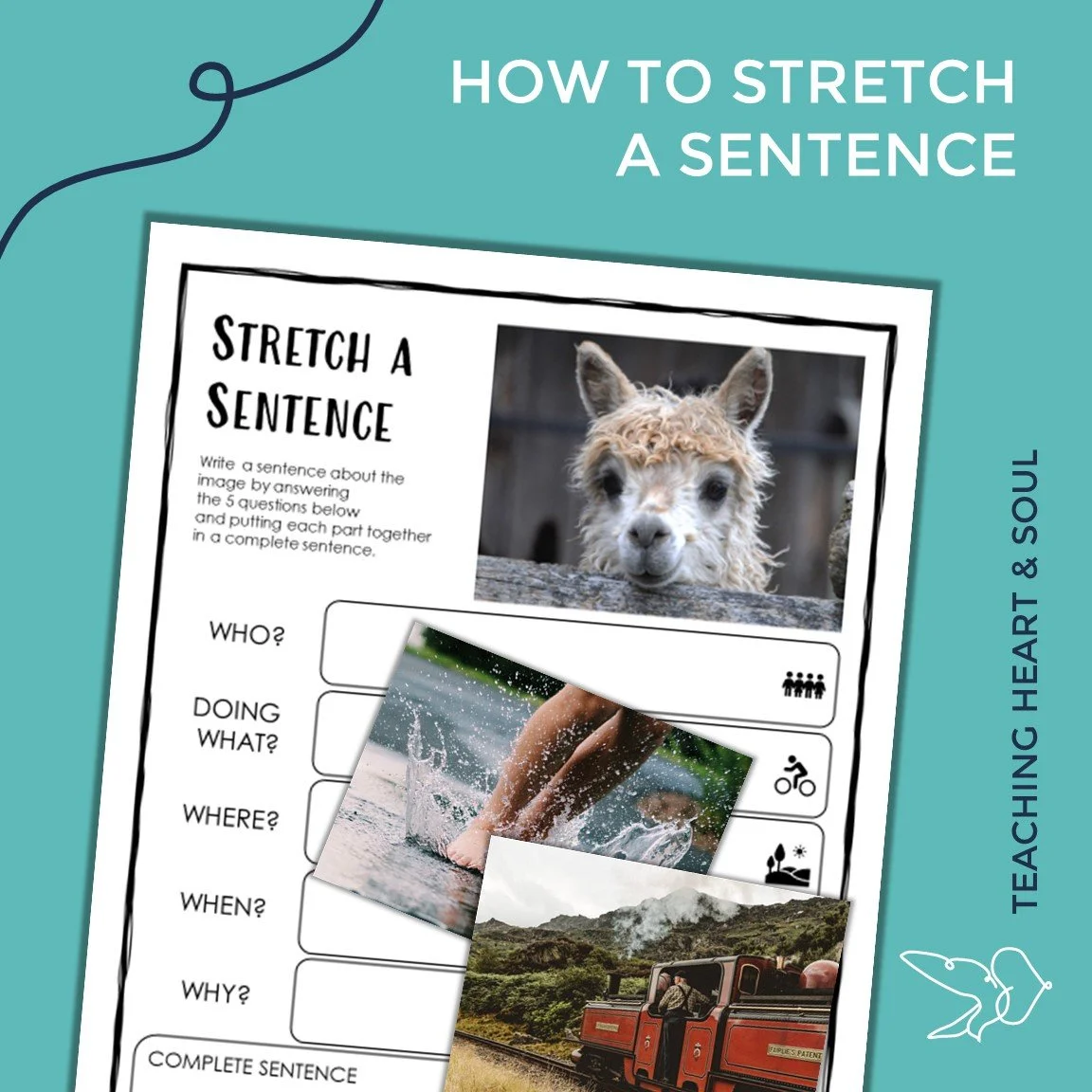Expanding Sentences with the “Stretch a Sentence” Technique
Writing sentences is a foundational aspect of writing.
You may notice your students writing the bare minimum - just a subject and verb - and not much else.
This is where teaching students to expand their sentences comes into play.
Expanding sentences is a crucial aspect of effective writing, as it allows for richer descriptions and more precise communication.
One way to do this is through the "Stretch a Sentence" strategy.
When to Use This Technique
This is a great technique to use in first grade, after students have learned what a complete sentence is, the terms “subject” and “verb” or “predicate,” and simple punctuation.
The next step for students is to learn to write longer more engaging sentences.
This is also a great strategy to use with older students who are doing the bare minimum, don't have enough details, or need help getting more creative with their sentences or narratives.
Stretching sentences is a great way to add more details to students' sentences, increase the length, and extend the information they are presenting. This is a step-by-step process that stretches students' writing abilities.
If you'd like help teaching this strategy to your students CLICK HERE for resources including task cards, worksheets, a PowerPoint presentation, and class poster. You can also find a FREE resource for teaching the RACE strategy HERE.
Who?
To start, students need to decide who the sentence is about. This is the first place students should start as they draft their sentences.
All sentences need a subject - the person or thing the sentence is about.
Who are they talking about in their sentence?
The answer will be a noun or a pronoun.
It could be a pet turtle, a firefighter, or Aunt Susan. Whoever they are talking about will come first before adding onto their sentence.
Doing What?
The next part of stretching a sentence is to answer the question “Doing what?”
What is that pet turtle doing? What is the firefighter up to? What is Aunt Susan doing?
During this part, encourage your students to add active verbs and use their imagination to make the sentence interesting.
The pet turtle could be splashing.
The firefighter might be climbing.
Aunt Susan could be squealing.
Where?
The next part of this strategy is to convey where the action is taking place. This gives the reader more context for the sentence.
Where is the pet turtle splashing? Where is the firefighter climbing? Where is Aunt Susan squealing?
The pet turtle might be splashing in the pond.
The firefighter could be climbing up to the window of a burning building.
Aunt Susan might be squealing at the kitchen table.
When?
Another important piece of information to convey is when an action is taking place. Oftentimes, this detail will come before the subject. So, help your students format this part of their sentence correctly.
When is the pet turtle splashing in the pond?
When was the firefighter climbing to the burning building?
When is Aunt Susan squealing?
This information could change the reader’s understanding of what’s happening.
The pet turtle could be splashing in the pond in the evening or in the middle of the night.
The firefighter could be climbing up to the burning building in the middle of the day, but perhaps this happened yesterday morning.
Aunt Susan might be squealing in the morning or after she sat down to dinner.
Why?
Answering the question “why?” helps the reader understand any context that can’t be inferred.
Why is the pet turtle splashing?
In the middle of the night, the pet turtle splashes in the pond because an owl swooped toward him.
Why was the firefighter climbing?
Yesterday morning, the firefighter climbed up to the window of the burning building to save the little boy.
Why was Aunt Susan squealing?
Aunt Susan started squealing at the dinner table after she sat down to dinner because her friends surprised her with a party.
If you'd like help teaching this strategy to your students CLICK HERE for a great resource that includes task cards, worksheets, a PowerPoint presentation, and class poster.
More Examples
Remember, to follow the “Stretch a Sentence” strategy, you need to answer the “5 Ws.”
Who? (Doing) What? Where? When? Why?
See if you can find the answer to each question in the sentences below:
At the beginning of the day, I stretch my long legs next to my bed to relieve the tension in my muscles.
Last week, La'Nya walked along the narrow coastline to feel the warm sun on her face and the soft sand beneath her feet.
Before ballet, my class practiced stretching our arms and legs to the horizon to prepare for our exercise.
Miles away from the highway, after a long day of working the land, the farmer waded into the river up to his neck to cool off from the hot sun.
At half past noon, we walked a long distance to the point where we could cross the river to get to the site of the crash.
After running a distance of 5 miles on the treadmill, my body was burning because the muscles in my arms and legs were tight.
As soon as we got to the beach, my cousins buried me up to my neck for fun.
When Less Is More
If you read the example sentences above, you'll notice that consistently expanding sentences in writing can get tiresome.
Teaching students to stretch their sentences is important, but it can be overused.
Practice including each piece of the "5 Ws" as students write sentences, but as they gain this skill, encourage more diversity in their sentences, rather than answering each of the 5 questions in every sentence.
Stretching Sentences Sample Activity
Learning Objective
Students will use the "stretch a sentence" strategy to enhance their sentences by answering the questions Who? Doing what? When? Where? and Why?
Materials
Whiteboard and markers
Simple sentences on cards (e.g. The dog barked. The girl laughed. They cheated. The cat turned. My friend sat. Neveah skipped. Esteban ate.)
Pencils and blank sheets of lined paper for each student
Lesson Plan
Explain to your students that they will be learning to add more details to their sentences by using the "stretch a sentence" technique.
Write the 5 Ws on the white board: Who? Doing What? When? Where? Why?
Explain that these questions help add details to sentences. Students will practice answering these questions to stretch their sentences.
Model how to use the stretch a sentence strategy by drawing a card with a simple sentence on it. Write the sentence on the board. Then, show how the sentence already answers two of the 5 W questions: Who? and Doing What? Add onto the sentence by answering the other 3 questions: When? Where? and Why?
Read the expanded example sentence.
Ask students to compare the expanded sentence with the original simple sentence. Prompt students to discuss how the extended sentence is more detailed.
Guide students to write another sentence with you by following the same steps and asking for class input.
Have students draw their own cards and turn their simple sentences into expanded sentences on a blank sheet of lined paper.
Have students take turns sharing the sentences they've written with a shoulder partner.
To help facilitate teaching this strategy to your students CLICK HERE for resources including task cards, worksheets, a PowerPoint presentation, and class poster.
Further Practice
For further practice, find a picture online and have students write an expanded sentence about it. For example, use the National Geographic best photo of the day and have students answer the questions Who? Doing What? When? Where? and Why? on a blank sheet of lined paper.
This can be a daily exercise until students get the hang of writing sentences with more details.
Stretching Sentences Analogy
Stretching a sentence can be compared to preparing for a marathon.
Short Stretch
Before you run a marathon, you should practice running a short stretch. This is not the end goal, but it is an important step in the journey. Similarly, students should learn to write short sentences before learning to stretch a sentence.
For example,
The dog sits.
My friend eats food.
Long Stretch
After mastering shorter distances, a runner should go for a long stretch. Likewise, students should practice stretching their sentences by adding more details.
In the examples above, students might stretch their sentences to include a detail or two. This is a great time to add adjectives.
The fluffy brown dog sits down.
My best friend eats delicious food.
Final Stretch
Finally, it is important for students to be able to complete the last stretch where they stretch miles past what they were able to do at the beginning of their writing journey, just as a runner completes the final stretch of a marathon.
In these sentences, students include details and finishing touches to their sentences. This may be the largest stretch for young writers, but it is an important step for students to complete the full stretch of what they are able to do.
Conclusion
Stretching sentences is a fundamental skill for writing. It involves taking a simple sentence and transforming it into a more elaborate one with details, adjectives, and adverbs. Showing students examples of what this can look like will help them, and providing sentence stretch activities is a great way to practice this new skill.
Expanding sentences in writing helps students write a more interesting sentence that engages the reader. A stretched sentence includes details and descriptive words. It may be a big stretch for some students who are learning to write, but when students start stretching sentences, they stretch themselves and grow their writing.
Expanding sentences using the 5 Ws may be the next stretch of your students' writing journey.
Further Reading
Check out more information on how to scaffold writing instruction HERE.
Learn about the 6+1 Writing Traits HERE.
Find out how to practice restating the question HERE.
